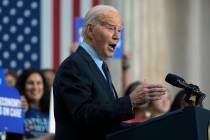NEVADA VIEWS: Clark County School District Decentralization: back to basics
On Sept. 30, the State Board of Education and Clark County School District Board of Trustees held a joint meeting to discuss the implementation of the district’s reorganization (known by many as Assembly Bill 469). This law, passed in 2017, sought to provide more local oversight of schools by creating School Organizational Teams and allowing more school-level autonomy by “decentralizing” the district.
During this meeting, and in response to critiques regarding the district’s lack of implementation of AB469, district officials cited a study from the Council of Great City Schools that noted several large school districts increased student achievement by implementing a “centralized” decision-making model. State Board of Education member Rene Cantu insightfully pointed out the natural tension — the reorganization law sought increased decentralization of the district, while district officials disagreed and thought a more centralized model (or at least a more centralized model than was proposed by the reorganization law) was the proper path forward.
While this tension was not resolved during the meeting, State Board of Education President Felicia Ortiz wondered if a decentralized model with district-imposed centralized “guardrails” was the answer. This, of course, begs the question of how far-reaching the guardrails that the district develops would be. Perhaps the answer can be found by revisiting the implementation strategies discussed immediately following the adoption of AB469.
When the reorganization law was adopted, many cited successful districts that embraced a more decentralized approach to education. Specifically highlighted were Michael Strembitsky’s efforts to increase student outcomes in Edmonton, Canada. After adopting the reorganization law, Nevada hired Strembitsky to provide initial guidance to the CCSD regarding how the district could decentralize. As an employee of the district at the time, I sat in on several meetings in which Strembitsky discussed his “Empowerment Model,” which sought to provide more authority to building principals and teachers. As he brought his model to Southern Nevada, many educators latched onto the first part of his message: empowering school-based staff to decide how to run their school.
However, a second part of the Empowerment Model that Strembitsky often discussed was that the superintendent and district leaders need a clear vision and benchmarks that principals and school leaders must meet. If schools cannot meet those benchmarks, the superintendent (and district) must have the authority to remove those administrators who are not performing.
Similarly, Strembitsky argued that principals also must have the ability to set expectations for their staff (based upon the vision of district leadership). And if those individuals do not meet expectations, the administrator must have the authority to replace them with teachers who can meet the expectations.
The model Strembitsky detailed was logical and flowed from the understanding that those closest to the students have the most significant impact on them (and should be empowered to make decisions that will benefit their students). However, it was also predicated on a strong accountability model, whereby centralized forces create the vision for the schools and “empower” the schools to achieve that vision. A truly well-functioning system would allow that, whenever a breakdown occurred — whether it be with an educator, a school leader or central office staff that was hindering a school’s progress — immediate action was available.
To implement the intent and spirit of the reorganization law will require more than just a willingness on the part of the district. It will also take candid and, at times, uncomfortable conversations around what accountability measures are necessary to ensure students are meeting the required benchmarks — whatever the district determines them to be.
While the current discussions about the role of School Operational Teams and the authority of principals to hire/fire employees based on the existing bargaining agreements will be necessary, it seems these conversations may be premature. The first question that must be answered: What are we “empowering” principals to change? In a decentralized environment without a shared vision, one school may focus on improving proficiency rates, another on student growth, another chronic absenteeism, another closing opportunity gaps, etc. These goals do not need to be mutually exclusive, but they are certainly not the same.
Without clear benchmarks, achieving a quality and equitable education for all students will be challenging — with or without decentralization. While the district does have a strategic plan — with its 107 data points and 198 strategies — it is currently too broad and unwieldy to act as “guardrails” for schools to implement. Instead, the district should identify three to five overarching goals per elementary, middle and high school. And then, the district should empower school-based staff to find the best policies and techniques to achieve those targets based on their knowledge of the needs of the school.
In short, a successful decentralized model is predicated on a clear vision and strong accountability systems. It is not clear either currently exists. Only with those in place can we work toward ensuring all our students receive the best possible education, thus expanding the “pockets of excellence” we often see across the district.
— Kenneth J. Retzl is the director of education policy at the Guinn Center, a nonpartisan research center in Nevada.




























